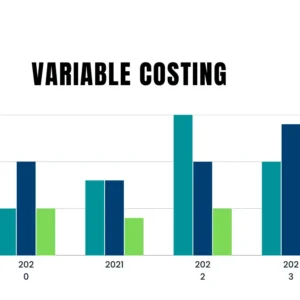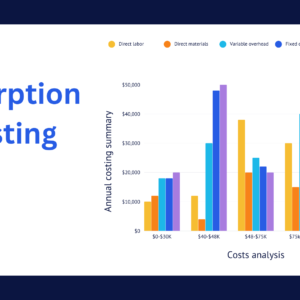Introduction
Manufacturing overhead is a critical element in the world of manufacturing and plays a significant role in determining the overall cost of production. It encompasses various indirect costs that are necessary for running a manufacturing facility but cannot be directly attributed to specific products or services. Understanding manufacturing overhead is essential for accurate costing, pricing, and financial decision-making. In this blog, we will explore the key concepts and components of manufacturing overhead.
We will delve into the different elements that make up manufacturing overhead, such as indirect materials, indirect labor, factory overhead expenses, depreciation and amortization, and utilities and maintenance costs. Additionally, we will discuss the methods of allocating manufacturing overhead and strategies for controlling and reducing these costs. By gaining a comprehensive understanding of manufacturing overhead, businesses can optimize their operations, improve profitability, and make informed financial decisions.
The Role of Manufacturing Overhead in Costing
Difference between direct costs and indirect costs
Direct costs are expenses that can be directly attributed to the production or provision of a specific product or service. These costs are easily traceable and can be assigned to a particular cost object. Examples of direct costs include raw materials, direct labor, and specific equipment or machinery used solely for a particular project.
On the other hand, indirect costs are expenses that are not directly tied to a specific product or service. These costs are incurred for the overall operation of the business and are shared across multiple products or services. Indirect costs are often referred to as overhead costs and include items like rent, utilities, administrative salaries, and maintenance expenses. Indirect costs are allocated or apportioned to various cost objects based on predetermined allocation methods or cost drivers.
Understanding the distinction between direct costs and indirect costs is essential for accurate cost analysis, pricing decisions, and financial reporting within a business.
Significance of allocating manufacturing overhead
Allocating manufacturing overhead is significant for several reasons in the realm of cost accounting and financial management:
Accurate product costing:
Manufacturing overhead represents a substantial portion of a company’s costs. By allocating these overhead expenses to individual products or services, businesses can calculate their true costs accurately. This information is vital for pricing decisions, profitability analysis, and determining the financial viability of different products or services.
Cost control and efficiency improvement:
Allocating manufacturing overhead allows businesses to identify and analyze the specific cost drivers behind their indirect expenses. This insight enables cost control initiatives and process improvements to reduce overhead costs and enhance operational efficiency.
Decision-making support:
Properly allocated manufacturing overhead provides management with reliable data for making informed decisions. Whether it’s expanding product lines, discontinuing unprofitable items, or optimizing resource allocation, understanding the true cost impact of overhead is crucial for making sound strategic choices.
Compliance and financial reporting:
Accurate allocation of manufacturing overhead ensures compliance with accounting standards and regulatory requirements. It also enables businesses to present their financial statements with transparency, providing stakeholders with a clear understanding of the company’s financial performance.
By allocating manufacturing overhead effectively, businesses gain a comprehensive understanding of their costs, optimize operations, and make informed decisions to drive financial success.
Impact of accurate overhead allocation on product pricing
The accurate overhead allocation has a significant impact on product pricing in several ways:
Cost-based pricing:
Accurate overhead allocation ensures that the true costs of production, including indirect expenses, are properly accounted for. This enables businesses to set prices that cover both direct costs and their fair share of overhead costs, ensuring profitability and sustainability.
Competitiveness:
Pricing products without considering overhead costs can result in underpricing, which may lead to losses. Accurate overhead allocation helps businesses establish competitive prices that reflect the true cost of production, allowing them to remain competitive in the market.
Profit margin optimization:
By accurately allocating overhead costs, businesses can determine the appropriate profit margin required to achieve their financial goals. This allows them to strike a balance between competitiveness and profitability, ensuring that their pricing strategy supports sustainable growth.
Pricing transparency:
Accurate overhead allocation provides transparency in pricing, allowing businesses to justify their pricing decisions to customers, stakeholders, and regulatory bodies. This builds trust and credibility, enhancing the overall perception of the business.
In summary, accurate overhead allocation enables businesses to establish fair and competitive prices that cover their costs while maximizing profitability. It ensures pricing transparency, supports financial goals, and helps maintain a strong market position.
Components of Manufacturing Overhead
Indirect materials
Indirect materials are materials that are necessary for the production process but are not directly traceable to a specific product. Examples include lubricants, cleaning supplies, and small tools. These materials contribute to the overall manufacturing overhead and are allocated to products based on predetermined allocation methods.
Indirect labor
Indirect labor refers to the workforce that is involved in the production process but does not directly engage in the creation of the final product. This includes employees such as supervisors, maintenance personnel, quality control inspectors, and other support staff who contribute to the overall manufacturing operations.
Factory overhead expenses
Factory overhead expenses, also known as manufacturing overhead costs, are indirect costs incurred in the manufacturing process that are not directly attributable to specific products or services. These expenses include items such as rent for the manufacturing facility, utilities (electricity, water, etc.), property taxes, insurance, equipment maintenance, factory supplies, and depreciation of machinery. Factory overhead expenses are essential to the overall functioning of the manufacturing facility and are allocated to the products or services produced based on predetermined allocation methods or cost drivers.
Depreciation and amortization
Depreciation and amortization are accounting methods used to allocate the cost of assets over their useful life. Depreciation applies to tangible assets like buildings and machinery, while amortization is used for intangible assets like patents and copyrights. These methods help businesses recognize the gradual loss in value or expiration of assets, allowing them to spread the cost over time. Depreciation and amortization expenses impact financial statements and affect the calculation of manufacturing overhead, as they are considered indirect costs associated with the production process.
Utilities and maintenance costs
Utilities and maintenance costs are significant components of manufacturing overhead. Utilities include expenses related to electricity, water, gas, and other essential services required for the operation of the manufacturing facility. Maintenance costs encompass expenditures for equipment repairs, routine maintenance, and facility upkeep. These expenses are considered indirect costs as they support the overall manufacturing process rather than being directly attributable to a specific product. Proper estimation and allocation of utilities and maintenance costs are crucial for accurately determining the total manufacturing overhead and ensuring the smooth functioning of the production environment.
Methods of Allocating Manufacturing Overhead
Traditional costing method
The traditional costing method is a widely used approach to allocate manufacturing overhead costs to products or services. It typically involves applying a predetermined overhead rate based on a single cost driver, such as direct labor hours or machine hours, to allocate overhead expenses. The method assumes that overhead costs are directly proportional to the chosen cost driver. While the traditional costing method is relatively straightforward to implement, it may lead to inaccuracies when the relationship between the cost driver and overhead costs is not linear. This limitation has prompted the adoption of more advanced costing methods like activity-based costing (ABC).
Advantages and disadvantages of traditional costing
| Advantages | Disadvantages |
| Simple and easy to understand | May result in inaccurate allocation of overhead costs |
| Quick and cost-effective to implement | Relies on arbitrary cost drivers |
| Familiarity among accountants and managers | Ignores variations in overhead cost drivers |
| Suitable for stable production environments | May lead to distorted product costs |
| Easily integrates with existing systems | Does not provide detailed insights on cost drivers |
Activity-based costing (ABC)
Activity-based costing (ABC) is a costing method that aims to allocate overhead costs more accurately by identifying and assigning costs to specific activities within an organization. Unlike the traditional costing method, which relies on broad cost drivers, ABC focuses on the activities that consume resources. It involves analyzing the activities performed, determining their cost drivers, and allocating overhead based on the usage of these drivers. ABC provides a more detailed and precise understanding of cost behavior, enabling businesses to make informed decisions about pricing, process improvement, and resource allocation.
Advantages and disadvantages of Activity-based costing
| Advantages | Disadvantages |
| More accurate allocation of overhead costs | Implementation can be time-consuming and complex |
| Provides detailed insights into cost drivers | Requires thorough data collection and analysis |
| Enhances cost control and process improvement | May require significant changes to existing accounting systems |
| Enables better pricing decisions | Higher implementation and maintenance costs |
| Supports resource allocation and efficiency | Requires collaboration and cooperation among departments |
Controlling Manufacturing Overhead
Importance of controlling overhead costs
Controlling overhead costs is of paramount importance for businesses due to several key reasons:
Cost efficiency:
Overhead costs, such as utilities, maintenance, and administrative expenses, can significantly impact a company’s bottom line. By controlling and minimizing these costs, businesses can improve their cost efficiency and increase profitability.
Competitive advantage:
Companies that effectively control their overhead costs can offer more competitive pricing to customers. Lower overhead allows for greater flexibility in pricing strategies, making the business more attractive to consumers.
Financial stability:
Excessive overhead costs can strain a company’s financial resources, potentially leading to cash flow problems and financial instability. By controlling overhead costs, businesses can maintain a healthier financial position and mitigate financial risks.
Resource optimization:
Overhead costs represent resources that could be better allocated to other areas of the business, such as research and development or marketing. By controlling overhead, companies can redirect resources to activities that drive growth and innovation.
Long-term sustainability:
Sustainable business operations require careful management of overhead costs. By controlling overhead, companies can improve their long-term viability, adapt to changing market conditions, and invest in future growth.
Overall, controlling overhead costs is crucial for improving financial performance, maintaining competitiveness, optimizing resource allocation, and ensuring the long-term sustainability of a business.
Strategies for reducing manufacturing overhead
Reducing manufacturing overhead requires a proactive approach and strategic implementation. Here are some effective strategies:
Process optimization:
Streamline production processes to eliminate waste, minimize inefficiencies, and increase productivity. Implement lean manufacturing principles and continuous improvement initiatives.
Technology utilization:
Invest in automation and advanced technologies to reduce labor costs and improve operational efficiency. Use software systems for inventory management, production planning, and resource allocation.
Energy conservation:
Implement energy-saving measures to reduce utility costs. Upgrade equipment for better energy efficiency, optimize lighting and HVAC systems and encourage energy-conscious behaviors among employees.
Supplier management:
Negotiate favorable terms with suppliers, explore bulk purchasing options, and seek competitive bids to lower material costs without compromising quality.
Overhead analysis:
Regularly review and analyze overhead expenses to identify areas of potential cost reduction. Challenge the necessity of each expense and seek cost-saving alternatives.
Cross-training and multi-skilling:
Train employees to handle multiple tasks and cross-train them in different areas, reducing the need for specialized labor and minimizing labor costs.
Inventory management:
Optimize inventory levels to minimize carrying costs and reduce storage space requirements. Implement just-in-time (JIT) inventory practices and accurate demand forecasting.
By implementing these strategies, businesses can effectively reduce manufacturing overhead, improve cost efficiency, and enhance overall profitability.
Conclusion
Understanding manufacturing overhead is crucial for businesses in the manufacturing sector as it plays a vital role in determining the true cost of production. By grasping the key concepts and components of manufacturing overhead, businesses can make informed decisions, accurately allocate costs, and optimize their operations.
Throughout this blog, we explored the components of manufacturing overhead, including indirect materials, indirect labor, factory overhead expenses, depreciation and amortization, and utilities and maintenance costs. We also discussed the methods of allocating manufacturing overhead, such as traditional costing and activity-based costing (ABC). Each component and method contributes to the overall understanding of manufacturing overhead and its impact on product pricing and financial management.
Accurate allocation of manufacturing overhead has numerous benefits. It allows for precise product costing, ensuring that all costs, including indirect expenses, are properly accounted for. This, in turn, supports effective pricing strategies and helps businesses maintain competitiveness in the market. Furthermore, accurate overhead allocation provides valuable insights into cost behavior and supports decision-making related to process improvement, resource allocation, and financial reporting.
Controlling overhead costs is essential for businesses to optimize profitability, maintain financial stability, and sustain long-term growth. By implementing strategies such as process optimization, technology utilization, energy conservation, and supplier management, businesses can effectively reduce manufacturing overhead and improve cost efficiency.
In conclusion, a comprehensive understanding of manufacturing overhead and its components empowers businesses to make informed decisions, accurately allocate costs, and control expenses. By managing manufacturing overhead effectively, businesses can enhance their competitiveness, maximize profitability, and ensure long-term success in the manufacturing industry.





[…] If you’re baking that cake in a fancy kitchen, the electricity, rent, and other bills are manufacturing overhead expenses. The Production Budget, it’s about adding up all these extra costs related to making […]
[…] Indirect labor costs are crucial for businesses to consider when budgeting and planning, as they contribute to the overall operational expenses. Effectively managing indirect labor ensures smooth business operations, employee support, and facility maintenance, thereby enhancing overall organizational efficiency and effectiveness. It is a part of manufacturing overhead. […]
Thank you for your sharing. I am worried that I lack creative ideas. It is your article that makes me full of hope. Thank you. But, I have a question, can you help me?